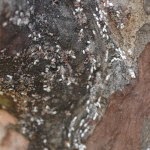Earlier this month, crape myrtle bark scale was found on a crape
myrtle outside of a business on Hwy. 64 in Oakland by a plant inspector with
the TDA. Crape myrtle bark scale is an
exotic species first discovered in the U.S. ten years ago in the Dallas, TX,
area. It is believed to be of Asian origin,
and has already made its way to Oklahoma, Arkansas, Louisiana, and, recently,
Tennessee. Last spring many trees in Germantown were infected with the scale,
but now we have our first case of it in Fayette County.
The insects attach themselves to the bark and twigs of the
crape myrtles and suck the sugary sap just under the bark. Even though they are very small, about 2 mm
long, it is easy to detect their presence.
As the insects feed, they secrete a sugary exudate which causes the
fungus sooty mold to grow on the trunk and limbs of the tree. The black,
unsightly sooty mold is the thing that a home gardener will notice first, not
the insect itself. After the sooty mold
is found, look for the grey to white insects, pink eggs, and crawlers. This is
the only scale insect known to attack crape myrtles, and when smashed, you will
see pink “blood.”
So, how do you keep your crape myrtles scale free? The first thing you should do is make sure
you look closely before you purchase a plant for your landscape. These insects are primarily being spread on
newly planted crape myrtles. If you find
them on your tree, there are a couple of things you can do to get control. You can spray your tree thoroughly with
horticultural oil during dormancy. This
is an organic treatment option that can be effective but it must be done while
there are no leaves on your tree. The second option is to use an insecticide
drench at the base of the tree. A couple
to try are Safari (dinotefuran) and Merit (imidacloprid). No matter what method
you use, it is important that you first wash the trunk and branches with a
brush and a mild solution of dish soap and water. This will get rid of some females and egg
masses as well as take off some of the ugly black sooty mold.
If you find this insect on your crape myrtles, feel free to
call me at Extension office at 465-5233.







